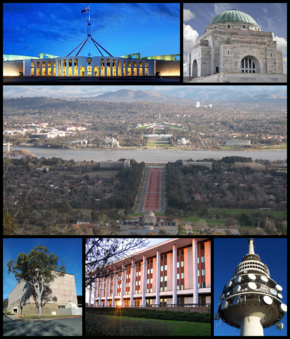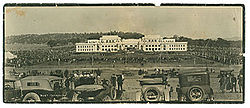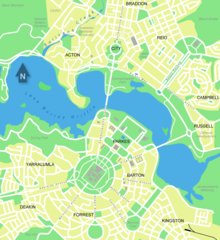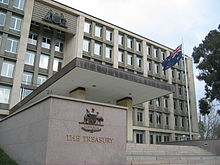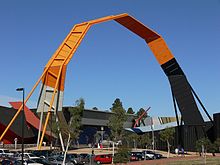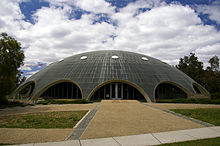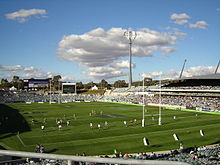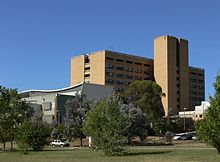
Canberra
Background Information
This selection is made for schools by a children's charity read more. All children available for child sponsorship from SOS Children are looked after in a family home by the charity. Read more...
Canberra (pron.: / ˈ k æ n b ᵊ r ə / or / ˈ k æ n b ɛr ə /) is the capital city of Australia. With a population of 367,000, it is Australia's largest inland city and the eighth-largest city overall. The city is located at the northern end of the Australian Capital Territory (ACT), 280 km (170 mi) south-west of Sydney, and 660 km (410 mi) north-east of Melbourne. A resident of Canberra is known as a "Canberran".
The site of Canberra was selected for the location of the nation's capital in 1908 as a compromise between rivals Sydney and Melbourne, Australia's two largest cities. It is unusual among Australian cities, being an entirely planned city outside of any state, similar to the American Federal District of Columbia. Following an international contest for the city's design, a blueprint by the Chicago architects Walter Burley Griffin and Marion Mahony Griffin was selected and construction commenced in 1913. The Griffins' plan featured geometric motifs such as circles, hexagons and triangles, and was centred around axes aligned with significant topographical landmarks in the Australian Capital Territory.
The city's design was influenced by the garden city movement and incorporates significant areas of natural vegetation that have earned Canberra the title of the "bush capital". The growth and development of Canberra were hindered by the World Wars and the Great Depression, which exacerbated a series of planning disputes and the ineffectiveness of a sequence of bodies that were to oversee the development of the city. The national capital emerged as a thriving city after World War II, as Prime Minister Robert Menzies championed its development and the National Capital Development Commission was formed with executive powers. Although the Australian Capital Territory is now self-governing, the federal government retains some influence through the National Capital Authority.
As the seat of the government of Australia, Canberra is the site of Parliament House, the High Court and numerous government departments and agencies. It is also the location of many social and cultural institutions of national significance, such as the Australian War Memorial, Australian National University, Australian Institute of Sport, National Gallery, National Museum and the National Library. The Australian Army's officer corps are trained at the Royal Military College, Duntroon and the Australian Defence Force Academy is also located in the capital.
The ACT, like Washington, D.C. in the United States, is independent of any state, to prevent any one state from gaining an advantage by hosting the seat of Federal power. Unlike Washington, however, the ACT has voting representation in the Federal Parliament, and has its own independent Legislative Assembly and government, similar to the states.
As the city has a high proportion of public servants, the federal government contributes the largest percentage of Gross State Product and is the largest single employer in Canberra. As the seat of government, the unemployment rate is lower and the average income higher than the national average, while property prices are relatively high, in part due to comparatively restricted development regulations. Tertiary education levels are higher, while the population is younger.
Etymology
The word "Canberra" is popularly claimed to derive from the word Kambera or Canberry and mean "meeting place" in the old Ngunnawal language of the local Ngabri people.
Alternatively, the name was reported by Queanbeyan newspaper owner John Gale in the 1860s to be an anglicisation of the indigenous name 'nganbra' or 'nganbira', meaning "hollow between a woman's breasts", and referring to the Sullivans Creek floodplain between Mount Ainslie and Black Mountain.
History
Before European settlement, the area in which Canberra would eventually be constructed was seasonally inhabited by Indigenous Australians. Anthropologist Norman Tindale suggested the principal group occupying the region were the Ngunnawal people, while the Ngarigo lived immediately to the south of the ACT, The Wandandian to the east, the Walgulu also to the south, Gandangara people to the north, and Wiradjuri to the north west. Archaeological evidence of settlement in the region includes inhabited rock shelters, rock paintings and engravings, burial places, camps and quarry sites, and stone tools and arrangements. The evidence suggests human habitation in the area for at least 21,000 years.
European exploration and settlement started in the Canberra area as early as the 1820s. There were four expeditions between 1820 and 1824. White settlement of the area probably dates from 1823, when a homestead or station was built on what is now the Acton peninsula by stockmen employed by Joshua John Moore. He formally applied to purchase the site on 16 December 1826, naming the property "Canberry". On 30 April 1827, Moore was told by letter that he could retain possession of 1,000 acres (405 ha) at Canberry.
The European population in the Canberra area continued to grow slowly throughout the 19th century. Among them was the Campbell family of "Duntroon"; their imposing stone house is now the officers' mess of the Royal Military College, Duntroon. The Campbells sponsored settlement by other farmer families to work their land, such as the Southwells of " Weetangera". Other notable early settlers included the inter-related Murray and Gibbes families, who owned the Yarralumla estate—now the site of the official residence of the Governor-General of Australia—from the 1830s through to 1881.
The oldest surviving public building in the inner-city is the Anglican Church of St John the Baptist, in the suburb of Reid, which was consecrated in 1845. St John's churchyard contains the earliest graves in the district. As the European presence increased, the indigenous population dwindled, mainly from disease such as smallpox and measles.
The decisions to start and locate a capital
The district's change from a rural area in New South Wales to the national capital started during debates over Federation in the late 19th century. Following a long dispute over whether Sydney or Melbourne should be the national capital, a compromise was reached: the new capital would be built in New South Wales, so long as it was at least 100 miles (160 km) from Sydney, with Melbourne to be the temporary seat of government (but not referred to as the "capital") while the new capital was built. Newspaper proprietor John Gale circulated a pamphlet titled ' Dalgety or Canberra: Which?' advocating Canberra to every member of the Commonwealth's seven States Parliaments. By many accounts, it was decisive in the selection of Canberra as the site in 1908, as was a result of survey work done by the government surveyor Charles Scrivener. The NSW government ceded the Federal Capital Territory (as it was then known) to the federal government. In an international design competition conducted by the Department of Home Affairs, on 24 May 1911, the design by Walter Burley Griffin and Marion Mahony Griffin was chosen for the city, and in 1913 Griffin was appointed Federal Capital Director of Design and Construction and construction began.
History of Canberra as a capital city
On 12 March 1913, the city was officially given its name by Lady Denman, the wife of Governor-General Lord Denman, at a ceremony at Kurrajong Hill, which has since become Capital Hill and the site of the present Parliament House. Canberra Day is a public holiday observed in the ACT on the second Monday in March to celebrate the founding of Canberra. After the ceremony, bureaucratic disputes hindered Griffin's work; a Royal Commission in 1916 ruled his authority had been usurped by certain officials. Griffin's relationship with the Australian authorities was strained and a lack of funding meant that by the time he was fired in 1920, little work had been done. By this time, Griffin had revised his plan, overseen the earthworks of major avenues, and established the Glenloch Cork Plantation.
The federal legislature moved to Canberra on 9 May 1927, with the opening of the Provisional Parliament House. The Prime Minister, Stanley Bruce, had officially taken up residence in The Lodge a few days earlier. Planned development of the city slowed significantly during the depression of the 1930s and during World War II. Some projects planned for that time, including Roman Catholic and Anglican cathedrals, were never completed.
From 1920 to 1957, three bodies, successively the Federal Capital Advisory Committee, the Federal Capital Commission, and the National Capital Planning and Development Committee continued to plan the further expansion of Canberra in the absence of Griffin; however, they were only advisory, and development decisions were made without consulting them, increasing inefficiency.
Immediately after the end of the war, Canberra was criticised for resembling a village, and its disorganised collection of buildings was deemed ugly. Canberra was often derisively described as "several suburbs in search of a city". Prime Minister Robert Menzies regarded the state of the national capital as an embarrassment. Over time his attitude changed from one of contempt to that of championing its development. He fired two ministers charged with the development of the city for poor performance. He ruled for over a decade and in that time the development of the capital sped up rapidly. The population grew by more than 50% in every five-year period from 1955 to 1975. Several Government departments, together with public servants, were moved to Canberra from Melbourne following the war. Government housing projects were undertaken to accommodate the city's growing population.
Most of rapid expansion was achieved after the National Capital Development Commission (NCDC) was formed in 1957 with executive powers, replacing its ineffective advisory predecessors. The NCDC ended four decades of disputes over the shape and design of Lake Burley Griffin—the centrepiece of Griffin's design—and construction was completed in 1964 after four years of work. The completion of the lake finally the laid the platform for the development of Griffin's Parliamentary Triangle. Since the initial construction of the lake, various buildings of national importance have been constructed on its shores.
The newly built Australian National University was expanded, and sculptures and monuments were built. A new National Library was constructed within the Parliamentary Triangle, followed by the High Court and the National Gallery. Suburbs in Canberra Central (often referred to as North Canberra and South Canberra) were further developed in the 1950s, and urban development in the districts of Woden Valley and Belconnen commenced in the mid and late 1960s respectively. Many of the new suburbs were named after Australian politicians, such as Barton, Deakin, Reid, Braddon, Curtin, Chifley and Parkes.
On 27 January 1972 the Aboriginal Tent Embassy was first established by indigenous people on the grounds of Parliament House; it was created to draw attention to indigenous rights and land issues and has been continuously occupied since 1992.
On 9 May 1988, a larger and permanent Parliament House was opened on Capital Hill as part of Australia's bicentenary celebrations, and the Federal Parliament moved there from the Provisional Parliament House, now known as Old Parliament House.
In December 1988, the ACT was granted full self-government through an Act of the Commonwealth Parliament. Following the first election on 4 March 1989, a 17-member Legislative Assembly sat at temporary offices at 1 Constitution Avenue, Civic, on 11 May 1989. Permanent premises were opened on London Circuit in 1994. The Australian Labor Party formed the ACT's first government, led by the Chief Minister Rosemary Follett, who made history as Australia's first female head of government.
Parts of Canberra were engulfed by bushfires on 18 January 2003 that killed four people, injured 435, and destroyed more than 500 homes and the major research telescopes of Australian National University's Mount Stromlo Observatory. Throughout 2013, several events will be held to celebrate the 100th anniversary of the naming of Canberra.
Geography
Canberra covers an area of 814.2 square kilometres (314.3 sq. mi) and is located near the Brindabella Ranges, approximately 150 kilometres (93 mi) inland from Australia's east coast. It has an elevation of approximately 580 metres (1,900 ft) AHD; the highest point is Mount Majura at 888 metres (2,913 ft). Other large hills include Mount Taylor 855 metres (2,805 ft), Mount Ainslie 843 metres (2,765 ft), Mount Mugga Mugga 812 metres (2,664 ft) and Black Mountain 812 metres (2,664 ft).
The native forest in the Canberra region was almost wholly eucalypt species and provided a resource for fuel and domestic purposes. By the early 1960s, logging had depleted the eucalypt, and concern about water quality led to the forests being closed. Interest in forestry began in 1915 with trials of a number of species including Pinus radiata on the slopes of Mount Stromlo. Since then, plantations have been expanded, with the benefit of reducing erosion in the Cotter catchment, and the forests are also popular recreation areas.
The urban environs of the city of Canberra straddle the Ginninderra plain, Molonglo plain, the Limestone plain, and the Tuggeranong plain (Isabella's Plain). The Molonglo River which flows across the Molonglo plain has been dammed to form the national capital's iconic feature Lake Burley Griffin. The Molonglo then flows into the Murrumbidgee north-west of Canberra, which in turn flows north-west toward the New South Wales town of Yass. The Queanbeyan River joins the Molonglo River at Oaks Estate just within the ACT.
A number of creeks, including Jerrabomberra and Yarralumla Creeks, flow into the Molonglo and Murrumbidgee. Two of these creeks, the Ginninderra and Tuggeranong, have similarly been dammed to form Lakes Ginninderra and Tuggeranong. Until recently the Molonglo River had a history of sometimes calamitous floods; the area was a flood plain prior to the filling of Lake Burley Griffin.
Climate
Canberra has a relatively dry oceanic climate with warm to hot summers and cool to cold winters. Canberra experiences warm, quite dry summers, and chilly winters with heavy fog and frequent frosts. Snow is rare in the CBD (central business district), but the surrounding areas get annual snowfall through winter and often the snow capped mountains can be seen from the CBD. The highest recorded maximum temperature was 42.2 °C (108.0 °F) on 1 February 1968.
The lowest recorded minimum temperature was −10 °C (14 °F) on 11 July 1971. Light snow often falls only once or twice per year but is usually not widespread and quickly dissipates. Canberra is protected from the west by the Brindabellas which create a slight rain shadow in Canberra's valleys.
Annual rainfall is the third lowest of the capital cities (after Adelaide and Hobart) but is spread fairly evenly over the seasons, with late spring bringing the highest rainfall. Thunderstorms occur mostly between October and April, owing to the effect of summer and the mountains. The area is not very windy and the breeze is at its strongest from August to November. Canberra is less humid than the nearby coastal areas.
| Climate data for Canberra Airport | |||||||||||||
|---|---|---|---|---|---|---|---|---|---|---|---|---|---|
| Month | Jan | Feb | Mar | Apr | May | Jun | Jul | Aug | Sep | Oct | Nov | Dec | Year |
| Record high °C (°F) | 42.0 (107.6) |
42.2 (108) |
37.5 (99.5) |
32.6 (90.7) |
24.5 (76.1) |
20.1 (68.2) |
19.7 (67.5) |
24.0 (75.2) |
28.6 (83.5) |
32.7 (90.9) |
38.9 (102) |
39.2 (102.6) |
42.2 (108) |
| Average high °C (°F) | 28.0 (82.4) |
27.1 (80.8) |
24.5 (76.1) |
20.0 (68) |
15.6 (60.1) |
12.3 (54.1) |
11.4 (52.5) |
13.0 (55.4) |
16.2 (61.2) |
19.4 (66.9) |
22.7 (72.9) |
26.1 (79) |
19.7 (67.5) |
| Average low °C (°F) | 13.2 (55.8) |
13.1 (55.6) |
10.7 (51.3) |
6.7 (44.1) |
3.2 (37.8) |
1.0 (33.8) |
−0.1 (31.8) |
1.0 (33.8) |
3.3 (37.9) |
6.1 (43) |
8.8 (47.8) |
11.4 (52.5) |
6.5 (43.7) |
| Record low °C (°F) | 1.8 (35.2) |
3.0 (37.4) |
−1.1 (30) |
−3.7 (25.3) |
−7.5 (18.5) |
−8.5 (16.7) |
−10.0 (14) |
−8.5 (16.7) |
−6.4 (20.5) |
−3.3 (26.1) |
−1.8 (28.8) |
1.1 (34) |
−10.0 (14) |
| Precipitation mm (inches) | 58.5 (2.303) |
56.4 (2.22) |
50.7 (1.996) |
46.0 (1.811) |
44.4 (1.748) |
40.4 (1.591) |
41.4 (1.63) |
46.2 (1.819) |
52.0 (2.047) |
62.4 (2.457) |
64.4 (2.535) |
53.8 (2.118) |
616.4 (24.268) |
| Avg. precipitation days | 7.3 | 6.7 | 6.9 | 7.3 | 8.4 | 9.8 | 10.5 | 11.1 | 10.2 | 10.4 | 9.8 | 7.8 | 106.2 |
| Mean monthly sunshine hours | 294.5 | 254.3 | 251.1 | 219 | 186 | 156 | 179.8 | 217 | 231 | 266.6 | 267 | 291.4 | 2,813.7 |
| Source #1: | |||||||||||||
| Source #2: | |||||||||||||
Urban structure
Canberra is a planned city and the inner-city area was originally designed by Walter Burley Griffin, a major 20th century American architect. Within the central area of the city near Lake Burley Griffin, major roads follow a wheel-and-spoke pattern rather than a grid. Griffin's proposal had an abundance of geometric patterns, including concentric hexagonal and octagonal streets emanating from several radii. However, the outer areas of the city, built later, are not laid out geometrically.
Lake Burley Griffin was deliberately designed so that the orientation of the components was related to various topographical landmarks in Canberra. The lakes stretch from east to west and divided the city in two; a land axis perpendicular to the central basin stretches from Capital Hill—the eventual location of the new Parliament House on a mound on the southern side—north northeast across the central basin to the northern banks along Anzac Parade to the Australian War Memorial. This was designed so that looking from Capital Hill, the War Memorial stood directly at the foot of Mount Ainslie. At the southwestern end of the land axis was Bimberi Peak, the highest mountain in the ACT, approximately 52 km south west of Canberra.
The straight edge of the circular segment that formed the central basin of Lake Burley Griffin was perpendicular to the land axis and designated the water axis, and it extended northwest towards Black Mountain. A line parallel to the water axis, on the northern side of the city, was designated the municipal axis. The municipal axis became the location of Constitution Avenue, which links City Hill in Civic Centre and both Market Centre and the Defence precinct on Russell Hill. Commonwealth Avenue and Kings Avenue were to run from the southern side from Capital Hill to City Hill and Market Centre on the north respectively, and they formed the western and eastern edges of the central basin. The area enclosed by the three avenues was known as the Parliamentary Triangle, and formed the centrepiece of Griffin's work.
The Griffins assigned spiritual values to Mount Ainslie, Black Mountain, and Red Hill and originally planned to cover each of these in flowers. That way each hill would be covered with a single, primary colour which represented its spiritual value. This part of their plan never came to fruition, as World War I slowed construction and planning disputes led to Walter's dismissal by Prime Minister Billy Hughes after the war ended.
The urban areas of Canberra are organised into a hierarchy of districts, town centres, group centres, local suburbs as well as other industrial areas and villages. There are seven residential districts, each of which is divided into smaller suburbs, and most of which have a town centre which is the focus of commercial and social activities. The districts were settled in the following chronological order:
- Canberra Central, mostly settled in the 1920s and 1930s, with expansion up to the 1960s, 25 suburbs
- Woden Valley, first settled in 1964, 12 suburbs
- Belconnen, first settled in 1966, 25 suburbs (1 not yet developed)
- Weston Creek, settled in 1969, 8 suburbs
- Tuggeranong, settled in 1974, 18 suburbs
- Gungahlin, settled in the early 1990s, 18 suburbs (6 not yet developed)
- Molonglo Valley, development began in 2010, 13 suburbs planned.
The Canberra Central district is substantially based on Walter Burley Griffin's designs. In 1967 the then National Capital Development Commission adopted the "Y Plan" which laid out future urban development in Canberra around a series of central shopping and commercial area known as the 'town centres' linked by freeways, the layout of which roughly resembled the shape of the letter Y, with Tuggeranong at the base of the Y and Belconnen and Gungahlin located at the ends of the arms of the Y.
Development in Canberra has been closely regulated by government, both through planning processes and the use of crown lease terms that have tightly limited the use of parcels of land. Land in the ACT is held on 99 year crown leases from the national government, although most leases are now administered by the Territory government. There have been persistent calls for constraints on development to be liberalised.
Many of Canberra's suburbs are named after former Prime Ministers, famous Australians, early settlers, or use Aboriginal words for their title. Street names typically follow a particular theme; for example, the streets of Duffy are named after Australian dams and reservoirs, the streets of Dunlop are named after Australian inventions, inventors and artists and the streets of Page are named after biologists and naturalists. Most diplomatic missions are located in the suburbs of Yarralumla, Deakin and O'Malley. There are three light industrial areas: the suburbs of Fyshwick, Mitchell and Hume.
Governance
Outside Canberra, the Australian Capital Territory has no settlements larger than a village. The Australian Capital Territory Legislative Assembly performs the roles of both a city council and territory government. The assembly consists of 17 members, elected from three districts using proportional representation. The three districts are Molonglo, Ginninderra and Brindabella, which elect seven, five and five members, respectively.
The Chief Minister is elected by the Members of the Legislative Assembly (MLA) and selects colleagues to serve as ministers alongside him or her in the Executive, known informally as the cabinet. Whereas the ACT has federally been dominated by Labor, the Liberals have been able to gain some footing in the ACT Legislative Assembly, and were in government for just over eight of the Assembly's 21-year history, mostly during a period of six and half years from 1995 and 2001, when Labor won power. At the 2004 election the Australian Labor Party, headed by then Chief Minister Jon Stanhope, won nine of the 17 seats and formed the ACT's first majority government, but after the 2008 election was forced into minority government with the Greens.
As almost all of the ACT's population lives in Canberra, political trends for both areas are closely aligned. The ACT was given its first federal parliamentary representation in 1949, when it gained a seat in the House of Representatives, the Division of Australian Capital Territory. The ACT member could only vote on matters directly affecting the territory. In 1974, the ACT was allocated two Senate seats. In 1974, the House of Representatives seat was divided into two.
A third was created in 1996, but was abolished in 1998 because of changes to the regional demographic distribution. Both House of Representatives seats have mostly been held by Labor, usually by comfortable margins. Labor has polled at least seven percentage points more than the Liberals at every federal election since 1990, and their average lead since then has been 15 percentage points. The ALP and the Liberal Party of Australia have always held one Senate seat each.
The Australian federal government retains some influence over the ACT government. In the administrative sphere, most frequently this is through the actions of the National Capital Authority which is responsible for planning and development in areas of Canberra which are considered to be of national importance or which are central to Griffin's plan for the city, such as the Parliamentary Triangle, Lake Burley Griffin, major approach and processional roads, areas where the Commonwealth retains ownership of the land or undeveloped hills and ridge-lines (which form part of the Canberra Nature Park). The national government also retains a level of control over the Territory Assembly through the provisions of the Australian Capital Territory (Self-Government) Act 1988. This federal act defines the legislative power of the ACT assembly.
The Australian Federal Police (AFP) provides all of the constabulary services in the territory in a manner similar to state police forces, under a contractual agreement with the ACT Government. The AFP does so through its community policing arm, ACT Policing ( Australian Capital Territory Police).
People who have been charged with offences are tried either in the ACT Magistrates Court or for more severe offences, the ACT Supreme Court. Prisoners were held in remand at the Belconnen Remand Centre in the ACT but usually jailed in New South Wales. The new prison, Alexander Maconochie Centre, was officially opened on 11 September 2008 by Jon Stanhope, the Chief Minister. The total cost for construction was $130 million. Courts such as a Small Claims Tribunal and a Family Court exist for civil law actions and other non-criminal legal matters.
Economy
In May 2012, the unemployment rate in Canberra was 3.4% which was lower than the national unemployment rate of 5.1%. As a result of low unemployment and substantial levels of public sector and commercial employment, Canberra has the highest average level of disposable income of any Australian capital city. The gross average weekly wage in Canberra is $1,554.50 compared with the national average of $1,345.20 (February 2012).
The median house price in Canberra as of September 2009 was $511,820, lower than only Sydney among capital cities of more than 100,000 people, having surpassed Melbourne and Perth since 2005. The median weekly rent paid by Canberra residents is higher than rents in all other states and territories. As at the March quarter of 2009 the median rent in Canberra was $420 per week, the third highest in the country. Factors contributing to this higher weekly rental market include; higher average weekly incomes, restricted land supply, and inflationary clauses in the ACT Residential Tenancies Act.
The city's main industry is government administration and defence, which accounted for 31% of Gross Territory Product in 2008–09 and employed over 40% of Canberra's workforce. A number of Australian Defence Force establishments are located in or near Canberra, most notably the Australian Defence Force headquarters and HMAS Harman, which is a naval communications centre that is being converted into a tri-service, multi-user depot.
The former RAAF Fairbairn, adjacent to the Canberra International Airport was sold to the operators of the Airport, but the base continues to be used for RAAF VIP flights. A growing number of independent software vendors have based themselves in Canberra, to capitalise on the concentration of government customers; these include Tower Software and RuleBurst. A consortium of private and government investors is currently making plans for a billion-dollar data hub, with the aim of making Canberra a leading centre of such activity in the Asia-Pacific region.
Demographics
As of 2006, the population of Canberra was 323,056 people. The 2006 census showed that 1.2% of Canberra's population were of indigenous origin and 21.7% were born overseas. The largest group of people born overseas came from English-speaking countries, led by the United Kingdom and then New Zealand.
Significant numbers of immigrants have also come from China, India and Vietnam. Recent immigrants have arrived from countries in East and South Asia. Most locals are native speakers of English (81.1%); some have a second language, the most common being Mandarin, Italian, Vietnamese, Cantonese and Greek. These five languages are spoken by a total of 4.8% of the population.
Canberrans are relatively young, highly mobile, and well educated. The median age is 34 years, and only 9.8% of the population is aged over 65 years. Between 1996 and 2001, 61.9% of the population either moved to or from Canberra, which is the second highest mobility rate of any Australian capital city.
As of May 2004, 30% of people in the ACT aged 15–64 had a level of educational attainment equal to at least a bachelor's degree, significantly higher that the national average of 19%. Approximately 60% of Canberra residents describe themselves as Christian, the most common denominations being Catholic and Anglican; 6% of the population practice a non-Christian religion and 23% are not religious.
As of 2002 the most common crimes in Canberra are property related crimes, unlawful entry with intent and motor vehicle theft. They affect 1,961 and 630 of every 100,000 persons respectively. Homicide and related offences—including murder, attempted murder, manslaughter and driving causing death—affect 1.5/100,000 persons, which is below the national average of 4.9/100,000. Rates of assault and sexual assault are also below the national average.
Education
The two main tertiary institutions are the Australian National University (ANU) in Acton and the University of Canberra (UC) in Bruce, with over 10,500 and 8,000 full-time-equivalent students respectively. Established in 1946, the ANU has always had a strong research focus and is ranked among the leading universities in the world and the best in Australia by The Times Higher Education Supplement and the Shanghai Jiao Tong World University Rankings. There are two religious university campuses in Canberra: Signadou in the northern suburb of Watson is a campus of the Australian Catholic University; St Mark's Theological College in Barton is part of the secular Charles Sturt University.
The Australian Defence Force Academy (ADFA) and the Royal Military College, Duntroon are located in the inner-northern suburb of Campbell. ADFA teaches military undergraduates and postgraduates and is a campus of the University of New South Wales; Duntroon provides Australian Army officer training. Tertiary level vocational education is also available through the multi-campus Canberra Institute of Technology.
In February 2004 there were 140 schools in Canberra; 96 were operated by the government and 44 were private. During 2006, the ACT Government announced closures of up to 39 schools, to take effect from the end of the school year, and after a series of consultations unveiled its Towards 2020: Renewing Our Schools policy. As a result, some schools closed during the 2006–08 period, while others were merged; the creation of combined primary and secondary government schools will proceed over the next decade. The new policy has provoked significant opposition. Most suburbs are planned to include a primary and a nearby preschool; these are usually located near open areas where recreational and sporting activities are easily available.
Arts and entertainment
Canberra is home to many national monuments and institutions such as the Australian War Memorial, the National Gallery of Australia, the National Portrait Gallery, the National Library, the National Archives, the Australian Academy of Science, the National Film and Sound Archive and the National Museum. Many Commonwealth government buildings in Canberra are open to the public, including Parliament House, the High Court and the Royal Australian Mint.
Lake Burley Griffin is the site of the Captain James Cook Memorial and the National Carillon. Other sites of interest include the Black Mountain Tower, the Australian National Botanic Gardens, the National Zoo and Aquarium, the National Dinosaur Museum and Questacon – the National Science and Technology Centre.
The Canberra Museum and Gallery in the city is a repository of local history and art. Several historic homes are open to the public: Lanyon and Tuggeranong Homesteads in the Tuggeranong Valley, Mugga-Mugga in Symonston, and Blundells' Cottage in Parkes all display the lifestyle of the early European settlers. Calthorpes' House in Red Hill is a well preserved example of a 1920s house from Canberra's very early days. Canberra has many venues for live music and theatre: the Canberra Theatre and Playhouse which hosts many major concerts and productions; and Llewellyn Hall (within the ANU School of Music), a world-class concert hall are two of the most notable. The Street Theatre is a venue with less mainstream offerings. The Albert Hall was the city's first performing arts venue, opened in 1928. It was the original performance venue for theatre groups such as the Canberra Repertory Society.
Stonefest at the University of Canberra is a large two-day music festival. There are numerous bars and nightclubs which also offer live entertainment, particularly concentrated in the areas of Dickson, Kingston and the city. Most town centres have facilities for a community theatre and a cinema, and they all have a library. Popular cultural events include the National Folk Festival, the Royal Canberra Show, the Summernats car festival, the Canberra Multicultural Festival in February and the Celebrate Canberra festival held over 10 days in March in conjunction with Canberra Day.
Canberra maintains sister-city relationships with both Nara, Japan and Beijing, China. Canberra has friendship-city relationships with both Dili, East Timor and Hangzhou, China. City-to-city relationships encourage communities and special interest groups both locally and abroad to engage in a wide range of exchange activities. The Canberra Nara Candle Festival held annually in spring, is a community celebration of the Canberra Nara Sister City relationship. The festival is held in Canberra Nara Park on the shores of Lake Burley Griffin.
Sport
In addition to local sporting leagues, Canberra has a number of sporting teams that compete in national and international competitions. The best known teams are the Canberra Raiders and the Brumbies who play rugby league and rugby union respectively; both have been champions of their leagues. Both teams play their home games at Canberra Stadium, which is the city's largest stadium and was used to hold group matches in soccer for the 2000 Summer Olympics and in rugby union for the 2003 Rugby World Cup. The city also has a successful basketball team, the Canberra Capitals, which has won seven out of the last eleven national women's basketball titles. Canberra United FC represents the city in the W-League, the national women's association football league, and were champions in the 2011-12 season.
There are also teams that participate in national competitions in netball, field hockey, ice hockey, cricket and baseball. Manuka Oval is another large outdoor sporting facility where cricket and Australian Rules football are played. The Melbourne based AFL team the Kangaroos played some home games at Manuka Oval until July 2006. Following the move of the Kangaroos' alternative home ground to Carrara in Queensland, Melbourne and the Western Bulldogs will play home games at Manuka Oval from 2007 against the Sydney Swans. Canberra is also home to the Barassi International Australian Football Youth Tournament. The historic Prime Minister's XI cricket match is played at Manuka Oval annually. Other significant annual sporting events include the Canberra Marathon and the City of Canberra Half Ironman Triathlon. The Canberra Women's Tennis Classic was held in the lead up to the Australian Open until 2006.
The Australian Institute of Sport (AIS) is located in the Canberra suburb of Bruce. The AIS is a specialised educational and training institution providing coaching for elite junior and senior athletes in a number of sports. The AIS has been operating since 1981 and has achieved significant success in producing elite athletes, both local and international. The majority of Australia's team members and medallists at the 2000 Summer Olympics in Sydney were AIS graduates.
Canberra has numerous sporting ovals, golf courses, skate parks, tennis courts and swimming pools that are open to the public. A Canberra-wide series of bicycle paths are available to cyclists for recreational and sporting purposes. Canberra Nature Parks have a large range of walking paths, horse and mountain bike trails. Water sports like sailing, rowing, dragon boating and water skiing are held on Canberra's lakes. The Rally of Canberra is an annual motor sport event and a facility for drag racing is currently being planned for construction.
Infrastructure
Health
Canberra has two large public hospitals, the approximately 600-bed Canberra Hospital—formerly the Woden Valley Hospital—in Garran and the 174-bed Calvary Public Hospital in Bruce. Both are teaching institutions. The largest private hospital is the Calvary John James Hospital in Deakin. Calvary Private Hospital in Bruce and Healthscope's National Capital Private Hospital in Garran are also major healthcare providers.
The Royal Canberra Hospital was located on Acton Peninsula on Lake Burley Griffin; it was closed in 1991 and was demolished in 1997 in a controversial and fatal implosion to facilitate construction of the National Museum of Australia. The city has 10 aged care facilities. Canberra's hospitals receive emergency cases from throughout southern New South Wales, and ACT Ambulance Service is one of four operational agencies of the ACT Emergency Services Authority. NETS provides a dedicated ambulance service for inter-hospital transport of sick newborns within the ACT and into surrounding New South Wales.
Transport
The automobile is by far the dominant form of transport in Canberra. The city is laid out so that arterial roads connecting inhabited clusters run through undeveloped areas of open land or forest, which results in a low population density; this also means that idle land is available for the development of future transport corridors if necessary without the need to build tunnels or acquire developed residential land. In contrast, other capital cities in Australia have substantially less green space.
Canberra's districts are generally connected by parkways—limited access dual carriageway roads with speed limits generally set at a maximum of 100 km/h. An example is the Tuggeranong Parkway which links Canberra's CBD and Tuggeranong, and bypasses Weston Creek. In most districts, discrete residential suburbs are bounded by main arterial roads with only a few residential linking in, to deter non-local traffic from cutting through areas of housing.
ACTION, the government-operated bus service, provides public transport throughout the city. Deane's Transit Group provides bus services between Canberra and nearby areas of New South Wales through their Transborder Express ( Murrumbateman and Yass) and Deane's Buslines ( Queanbeyan) brands. In the 2006 census, 7.7% of the journeys to work involved a bus; with 7.4% walking or cycling to work. There are two local taxi companies. Aerial Capital Group enjoyed monopoly status until the arrival of Cabxpress in 2007.
An interstate CountryLink railway service connects Canberra to Sydney. Canberra's railway station is in the inner south suburb of Kingston. Between 1920 and 1922 the train line crossed the Molonglo River and ran as far north as the city centre, although the line was closed following major flooding and was never rebuilt, while plans for a line to Yass were abandoned. A 1067 mm gauge construction railway was built in 1923 between the Yarralumla brickworks and the provisional Parliament House; it was later extended to Civic, but the whole line was closed in May 1927. Train services to Melbourne are provided by way of a CountryLink bus service which connects with a rail service between Sydney and Melbourne in Yass, about one hour's drive from Canberra.
Plans to establish a High speed rail service between Melbourne, Canberra and Sydney, have not been implemented, as the various proposals have been deemed economically unviable. The original plans for Canberra included proposals for railed transport within the city, however none eventuated. A railway connecting Canberra to Jervis Bay was also planned but never constructed.
Canberra is about three hours by road from Sydney on the Federal Highway (National Highway 23), which connects with the Hume Highway (National Highway 31) near Goulburn, and seven hours by road from Melbourne on the Barton Highway (National Highway 25), which joins the Hume Highway at Yass. It is a two hour drive on the Monaro Highway (National Highway 23) to the ski fields of the Snowy Mountains and the Kosciuszko National Park. Batemans Bay, a popular holiday spot on the New South Wales coast, is also two hours away via the Kings Highway.
Canberra International Airport provides direct domestic services to Sydney, Melbourne, Brisbane, Adelaide and Perth, with connections to other domestic centres. There are direct daily flights to Albury and Newcastle in New South Wales. No regular commercial international flights operate from the airport. Until 2003 the civilian airport shared runways with RAAF Base Fairbairn. In June of that year, the Air Force base was decommissioned and from that time the airport was fully under civilian control. The Air Force still retains a presence at Fairbairn, which is a leased area in the North East precinct of the airport. The only active unit is No 34 Squadron, which is responsible for the operations of the airforce's VIP transport aircraft which are used to transport Australian officials such as the Prime Minister, cabinet ministers, the Governor General, the leader of the opposition and high ranking defence force officers when travelling both internationally or within Australia. The Fairbairn area is also used by official aircraft carrying foreign heads of state or government when visiting Canberra.
Utilities
The government-owned ACTEW Corporation manages Canberra's water and sewerage infrastructure. ActewAGL is a joint venture between ACTEW and AGL, and is the retail provider of Canberra's utility services including water, natural gas, electricity, and also some telecommunications services via a subsidiary TransACT.
Canberra's water is stored in four reservoirs, the Corin, Bendora and Cotter dams on the Cotter River and the Googong Dam on the Queanbeyan River. Although the Googong Dam is located in New South Wales, it is managed by the ACT government. ACTEW Corporation owns Canberra's two wastewater treatment plants, located at Fyshwick and on the lower reaches of the Molonglo River.
Electricity for Canberra comes from the national power grid through substations at Holt and Fyshwick (via Queanbeyan). Some limited local renewable power is produced via a hydro generator on the main water supply pipeline for Canberra at Mount Stromlo and methane plants at waste landfill sites at Belconnen and Mugga Lane. Power was first supplied from a plant built in 1913, near the Molonglo River. The ACT has the highest rate of computer use and internet connection in Australia.
International relations
Sister cities
Canberra is twinned with:
- Beijing, China
- Nara, Japan
